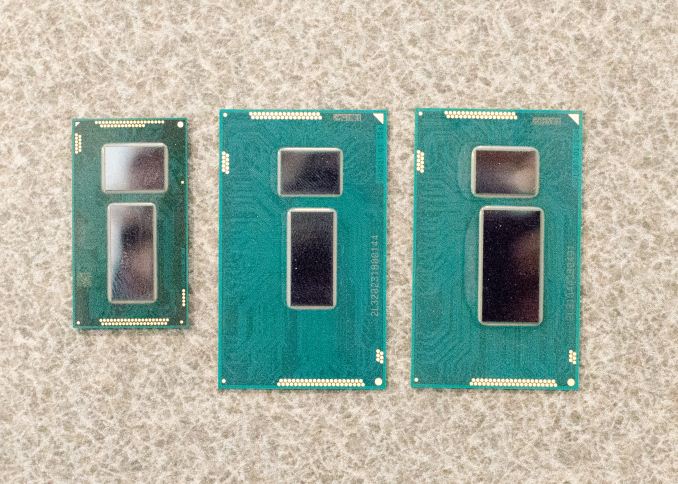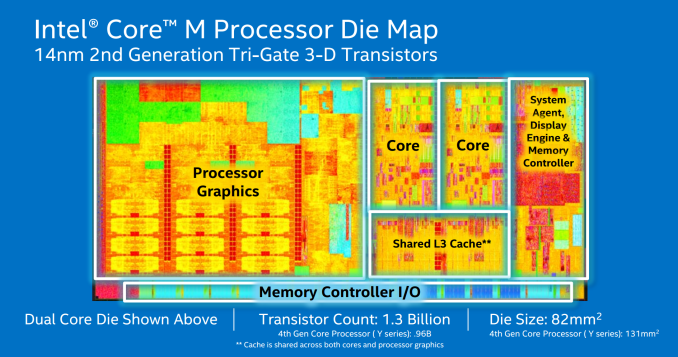More Intel Core M Coming Q4
by Ian Cutress on November 3, 2014 11:30 AM EST
Since Computex, there has been a lot of talk around Intel’s Broadwell-Y / Core-M CPU line. In August Intel treated us to a breakdown of the 14nm process and the Broadwell architecture including all the improvements therein, followed by a more succinct breakdown of the CPUs we should expect. These initial CPUs should be properly available to the public in Q4 in devices such as the Lenovo Yoga 3 Pro using the Core M-5Y70.
The news this week revolves around more Core M CPUs being pushed through the system. This is most likely as a result of Intel binning the CPUs in sufficient quantities to satisfy customers. The specifications are available at ark.intel.com, but the Core M line now stands at seven different SKUs:
| Intel Core M Specifications | |||||||
| 5Y71 (New) |
5Y70 | 5Y51 (New) |
5Y31 (New) |
5Y10c (New) |
5Y10a | 5Y10 | |
| Cores / Threads | 2 / 4 | 2 / 4 | 2 / 4 | 2 / 4 | 2 / 4 | 2 / 4 | 2 / 4 |
| Base Frequency / MHz | 1200 | 1100 | 1100 | 900 | 800 | 800 | 800 |
| Turbo Frequency / MHz | 2900 | 2600 | 2600 | 2400 | 2000 | 2000 | 2000 |
| Processor Graphics | HD 5300 | HD 5300 | HD 5300 | HD 5300 | HD 5300 |
HD 5300 |
HD 5300 |
| IGP Base Frequency / MHz | 300 | 100 | 300 | 300 | 300 | 100 | 100 |
| IGP Turbo Frequency / MHz | 900 | 850 | 900 | 850 | 800 | 800 | 800 |
| L3 Cache | 4 MB | 4 MB | 4 MB | 4 MB | 4 MB | 4 MB | 4 MB |
| TDP | 4.5 W | 4.5 W | 4.5 W | 4.5 W | 4.5 W | 4.5 W | 4.5 W |
| LPDDR3/DDR3L Support |
1600 MHz | 1600 MHz | 1600 MHz | 1600 MHz | 1600 MHz | 1600 MHz | 1600 MHz |
| Intel vPro | Yes | Yes | No | No | No | No | No |
| Intel TXT | Yes | Yes | No | No | No | No | No |
| Intel VT-d/VT-x | Yes | Yes | Yes | Yes | Yes | Yes | Yes |
| Intel AES-NI | Yes | Yes | Yes | Yes | Yes | Yes | Yes |
The new high end model is the 5Y71, offering a 2.9 GHz frequency mode and vPro features. The 5Y51 has slightly better specifications than the higher numbered 5Y70, but loses vPro compatibility. Both the 5Y31 and 5Y51 fill in the large gap between the 5Y10a and 5Y70 in the initial launch. All four new processors all have an improved base GPU frequency, up to 300 MHz, and are slated to work at a cTDP Up of 6W or cTDP Down of 3.5W, depending on the customer’s needs.
All new CPUs are slated for a Q4 launch, which would mean that they might become available for end users in products on the shelf sometime in Q1 2015.
Source: CPU-World











42 Comments
View All Comments
michael2k - Tuesday, November 4, 2014 - link
Again, you make my point for me. BayTrail isn't really competitive with the K1 nor the A8X. Price is Intel's problem, not ours. They could choose to price these things at $50 if they chose.The product these parts compete in at the 4.5W TDP are the A8X and the K1.
eddman - Tuesday, November 4, 2014 - link
Can you run windows (x86) on a tegra or apple chip?Intel Core is supposed to be used in PCs. No manufacturer will put a Core processor in an iOS or android device.
The competition to ARM processors is Atom, even though it's not able to compete with high-end ARM designs anymore. That might change with airmont; if intel even cares anymore. They can't become a major player by being so slow.
michael2k - Wednesday, November 5, 2014 - link
Why is that a relevant argument? You can run Windows on Atom; the only distinguishing features between Atom and Core is price and performance; given, as you say, that Atom is no longer performance competitive with ARM then that leaves Core M as being performance competitive with ARM.Again, price is Intel's problem; if Intel wishes to compete with ARM in the tablet space they need something more powerful than their current batch of Atom SoC.
eddman - Wednesday, November 5, 2014 - link
Can you not see it? Atom is nowhere as powerful as Core to be used on high-end ultraportable PCs.Intel is not targeting Core towards android at all. It is to be used with windows x86 devices only, where it can be useful.
Core is a complex and high performing architecture that cannot be produced on the cheap.
That is why Atom exists. As I said, airmont will be the one to compete with cortex-A5x ARMs, if it can manage to perform well enough, that is.
P.S. Core is still at least twice as fast as ARM when it comes to raw IPS performance, with A57 at about 4-5 DMIPS/MHz, yet Core is about 8-9.
casperes1996 - Monday, November 3, 2014 - link
Can anyone please explain the difference between y10 and y10a? y10c too for that matter if there's more than the gnu difference.DanNeely - Monday, November 3, 2014 - link
According to Wikipedia the y10 can cTDP down to 4W, the y10c cTDP up to 6W (and a 1ghz clock floor) while the y10 is locked at the baseline 4.5W. However ark.Intel.com doesn't list any cTDP options for the y10 and y10a; while listing the y10c as cTDPing to 3.5 or 6 from a base of 4.5.kavaron - Tuesday, November 4, 2014 - link
If someone is using windows core M with 1080p instead of 1800p will the battery life get a boost?kavaron - Tuesday, November 4, 2014 - link
If someone is using windows core M with 1080p instead of 1800p will the battery life get a boost?THE_DOM!NAT0R - Tuesday, November 4, 2014 - link
Well they keep postponing the Core M launch! That's bad! I want to buy a Core M device during this month!What is holding them up? It shouldn't be low production volumes. But rather retailers not selling enough of their old stock. Well.... you must lower the prices further to convince people to buy your 'old' products!
PhytochromeFr - Tuesday, November 4, 2014 - link
Lenovo Yoga 3 Pro, Panasonic RZ4 and Dell Latitude 7350 is launched at october.